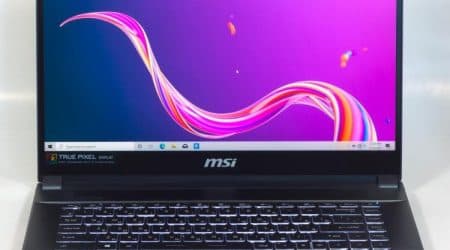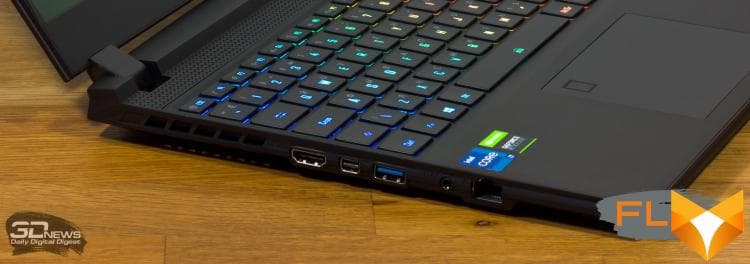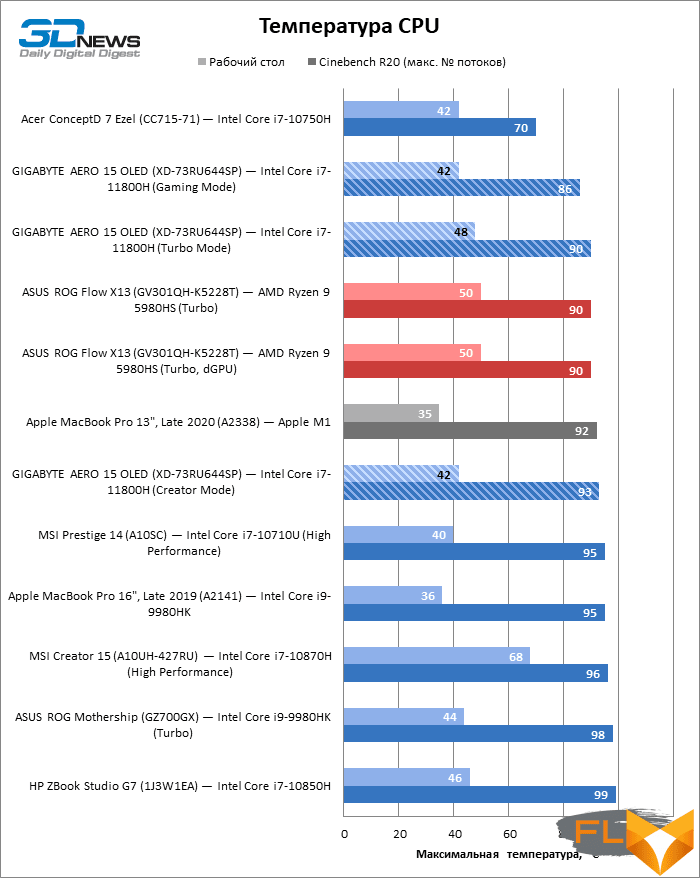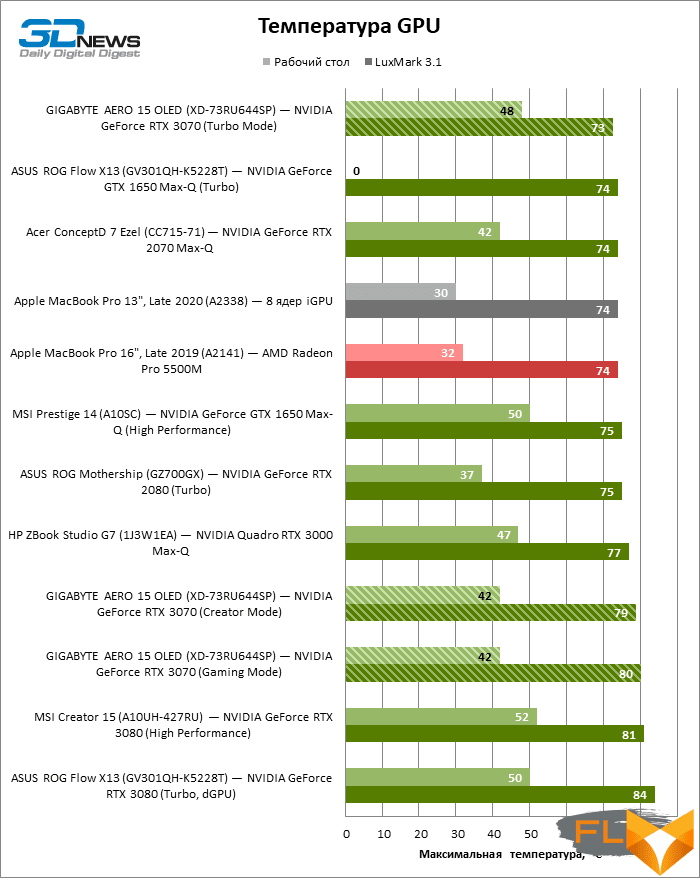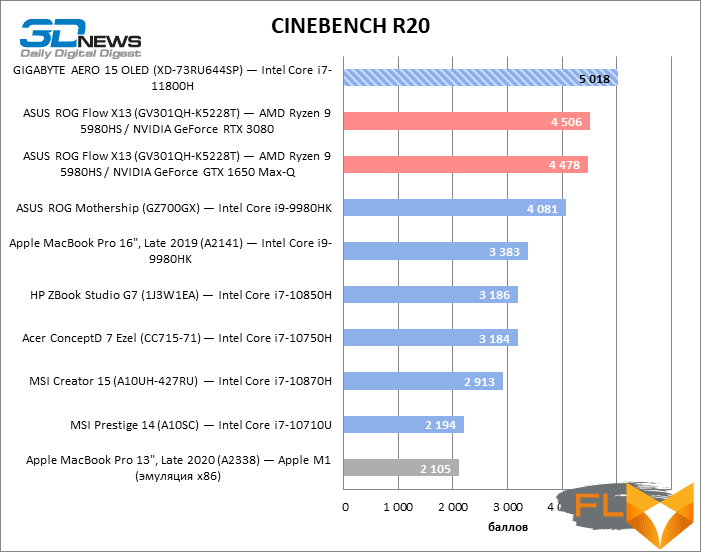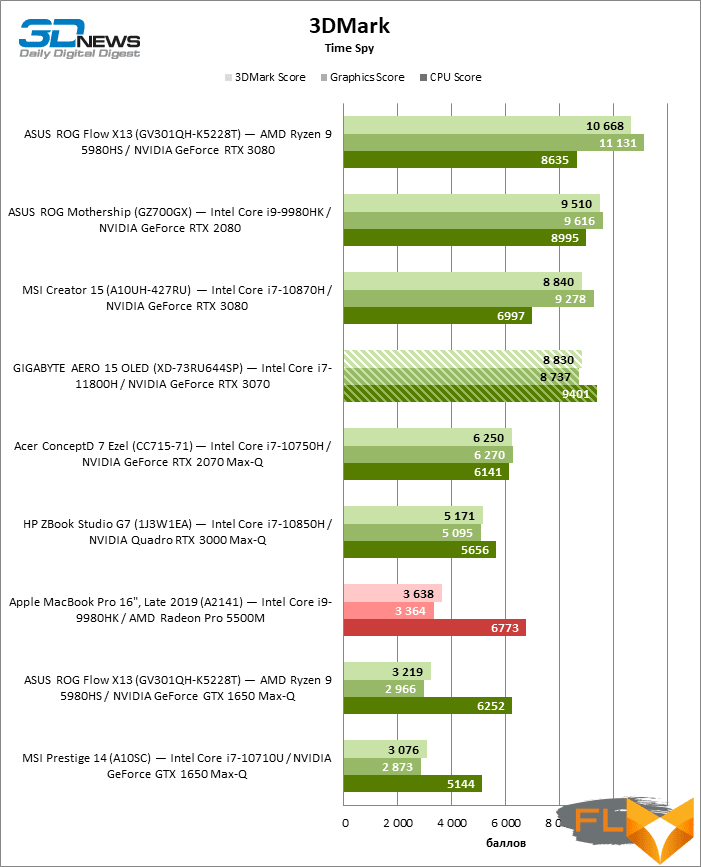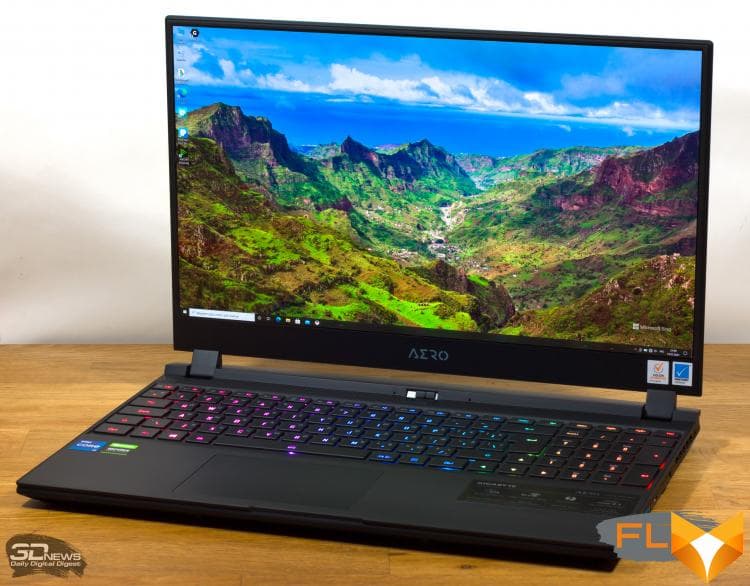


Mobile workstations in a thin ultrabook chassis have obvious advantages, but when you need maximum performance, upgrade options and a wide range of external interfaces, there is still no alternative to the standard form factor. GIGABYTE AERO 15 OLED is definitely one of the most powerful offerings in this category. In the new iteration of the AERO family, the manufacturer has replaced the 10th generation Intel chips with progressive Tiger Lake silicon, and older GeForce RTX 30 models are still used as discrete graphics. And of course, the updated AERO 15 retained its title feature – a screen based on AMOLED technology.
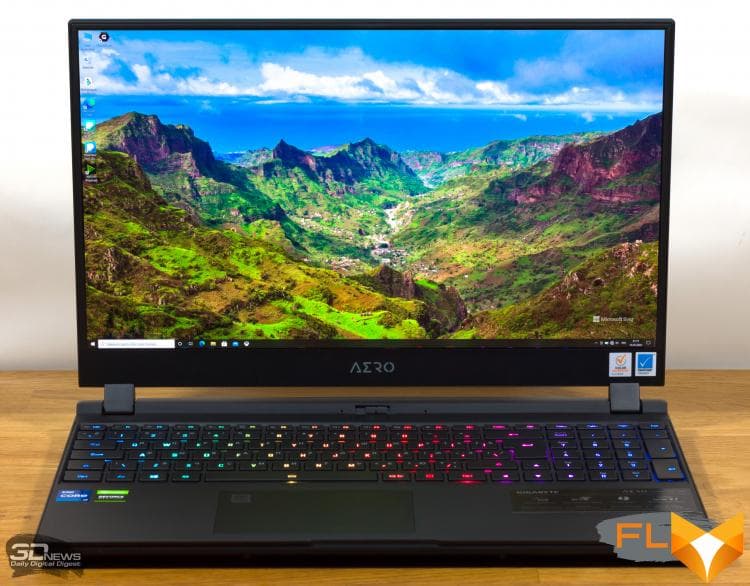
⇡#Specifications, prices
The upgraded GIGABYTE AERO 15 OLED is equipped with 11th generation Intel Core Tiger Lake processors with an H in the name, which indicates increased power reserve and up to eight x86 cores. At the same time, the configuration of the machine does not allow for a large variability of the main components. The central processor can be either a junior model Core i7 or an older Core i9. Both CPUs are eight-core, and the difference between them comes down to clock speeds and the nominal power consumption range.
As discrete graphics, GIGABYTE offers a mobile version of the GeForce RTX 3070 or RTX 3080. The advantage of the top model is not only and not so much in speed (both are based on the same GA104 processor, only with a different number of active computing units), but in a doubled array VRAM: 16 vs 8 GB. In games, this does not matter, but when editing video with a resolution of 8K or 3D rendering of complex models, a large amount of RAM is difficult to overestimate.
Modern NVIDIA GPUs and the Tiger Lake platform (unlike competing Ryzen 5000 series CPUs, by the way) support the fourth generation PCI Express bus. In addition, the Resizable BAR feature is enabled in the laptop BIOS, which allows the CPU to directly address the entire amount of local memory on the video adapter. Resizable BAR is known primarily for the fact that in some cases it allows you to significantly increase the gaming frame rate, but there is no reason to consider it useless for production applications. Finally, the laptop received NVIDIA Studio certification, which puts forward a number of requirements for mobile workstation hardware, and the computer comes pre-installed with the Studio series graphics driver instead of the usual gaming one.
The amount of system memory of the laptop reaches 64 GB in the factory. Unlike many thin laptops, the large form factor of the AERO 15 OLED is expandable with DDR4 3200 MT/s SO-DIMMs. The solid state drive here also takes advantage of the PCI Express 4.0 bus. SSD capacity – up to 2 TB.
| Manufacturer | GIGABYTE |
|---|---|
| Model | AERO 15 OLED |
| Display | 15.6”, 3840 × 2160 (60Hz), OLED |
| CPU | Intel Core i7-11800H (8/16 cores/threads, 2.3-4.6 GHz); Intel Core i9-11980HK (8/16 cores/threads, 2.6-5.0 GHz) |
| RAM | DDR4 SDRAM, 3200 MT/s, up to 64 GB (two channels) |
| GPU | NVIDIA GeForce RTX 3070 (8 GB GDDR6); NVIDIA GeForce RTX 3080 (16GB GDDR6) |
| Accumulator | SSD (PCIe 4.0 x4) up to 2TB |
| External I/O connectors | 3 × USB 3.2 Gen 1 Type-A; 1 × Thunderbolt 4 (USB4); 1 x Mini Display Port; 1 x HDMI; 1 x TRS 3.5mm |
| Network | 2.5G Ethernet; IEEE 802.11ax; Bluetooth 5.2 |
| Battery capacity, Wh | 99 |
| Weight, kg | 2 |
| Overall dimensions (L × H × D), mm | 356 × 250 × 19.9 |
| Retail price | From $3800 (Core i7-11800H, 16GB RAM, GeForce RTX 3080, 1TB SSD) |
However, you will not surprise anyone with powerful components and a large amount of memory when it comes to mobile computers that are not bound by the limitations inherent in ultrabooks. Another thing is a screen with 4K resolution, infinite contrast and DCI-P3 color gamut, which is also pre-calibrated and profiled.
Of course, a laptop with similar characteristics cannot be cheap. We found an intermediate configuration of the AERO 15 OLED in online stores, which includes a Core i7-11800H CPU, GeForce RTX 3080 video adapter, 16 GB of RAM and a 2 TB SSD, for a minimum price of $3800.
⇡#Look and Ergonomics
The GIGABYTE AERO 15 OLED case has not undergone any visible changes compared to the previous iteration of the laptop, which, in turn, looks no different from its predecessor, built on 10th generation Intel chips and GeForce 16/20 graphics. However, GIGABYTE had no reason to change the successful design of the AERO 15.
Before us is a heavy laptop weighing 2.2 kg (which is rounded up to 2 kg in the specifications) and almost 2 cm high from the table to the outer surface of the screen cover. But even though this is a rather thick machine, the manufacturer managed to keep the rest of the dimensions within reasonable limits thanks to the use of thin frames around the screen. The display was raised above the lower half of the case on two supports, but the rigidity of the structure was not affected at all as a result. The laptop is easy to open with one hand, and when closed, the screen rests on a rubber gasket. The matrix is glossy, but without glass lamination, which means that it is easy to guess that the screen does not respond to touch. But, in addition to a large margin of brightness, it has a fairly effective anti-reflective coating for working in bright light.
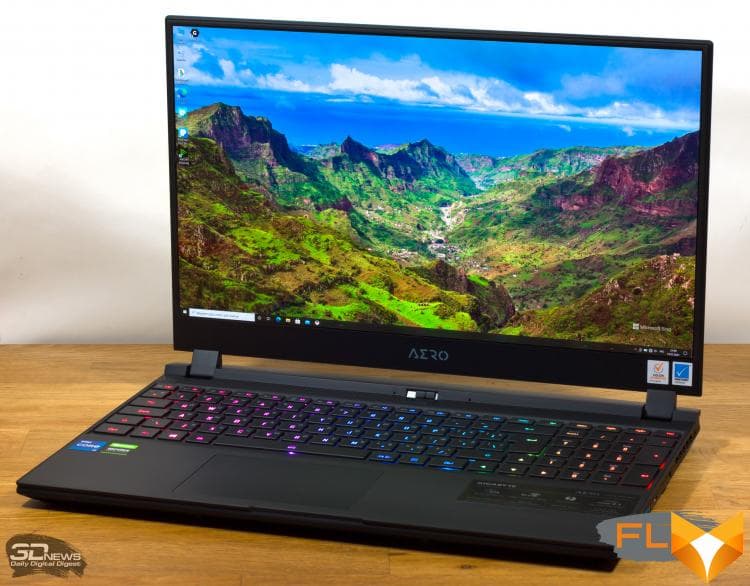
The machine is made in an aluminum case with rare plastic inserts. The overall build quality is at a high level, without any gaps and uneven joints between the panels. The only decorative elements that are reminiscent of GIGABYTE’s predominantly gaming past are the glowing logo on the screen lid and the carbon-look textured insert.
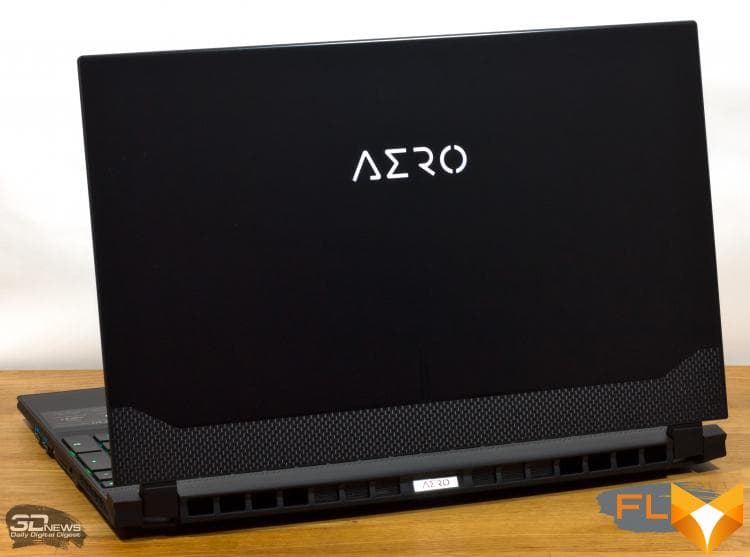
The AERO 15 OLED doesn’t have a hard surface like some of the laptops we’ve seen, but the base underneath the keyboard is stable enough to keep it from bouncing around while typing. The mechanics of the keys are also satisfactory, although the moment of actuation was not as clear as we would like. Most of the keys have a small recess and individual RGB backlighting – this is another sign of kinship with GIGABYTE gaming laptops, however, color markings will not interfere with work. The keyboard recognizes 80 simultaneous keystrokes and allows you to create macros to automate routine actions. Well, the main thing is, of course, the fact that the manufacturer did not stint on a full-size layout with a digital block, and none of the keys had to be cut in width.
The AERO 15 OLED has an excellent touchpad. The surface of the sensor does not look like glass, but it is perfectly tuned and well fixed in the body so that no extraneous sounds arise when lightly touching the panel. In the corner of the touchpad is a fingerprint scanner – the only means of biometric authentication, because there is no infrared camera. The usual webcam was moved from the top frame of the screen to the beveled ledge of the keyboard unit and covered the lens with a sliding shutter.

AERO 15 OLED has no shortage of ports for connecting peripherals. It has a total of four USB connectors: three Type-A USB 3.2 Gen1 standards and a single Thunderbolt 4 combined with USB4. There are also two separate video outputs (full size HDMI and Mini DisplayPort), a memory card reader and, most importantly, wired 2.5 Gigabit Ethernet.
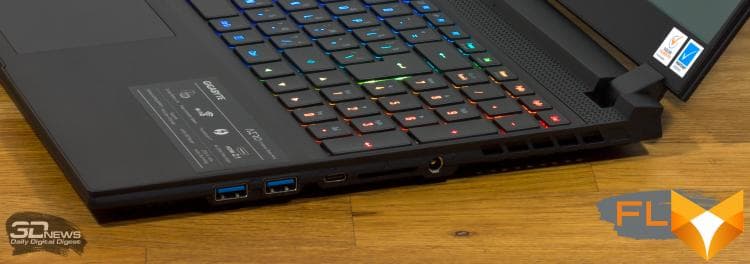
Of course, a laptop with components like the AERO 15 OLED does not have enough 100 W of power provided by the Thunderbolt interface to work from the network (the fourth version of the standard, unfortunately, did not bring any changes in this regard). Therefore, a massive power supply with a rated power of 230 watts is attached to the laptop.
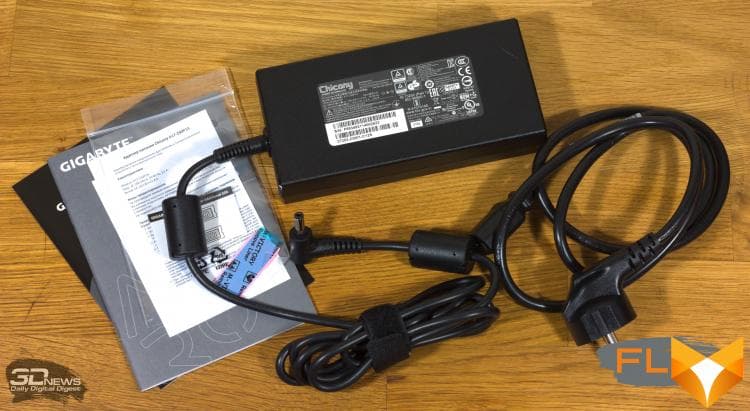
⇡#Internal design and upgrade options
Another advantage of classic form factor laptops over ultrabooks, in addition to a large number of expansion ports, is, of course, the possibility of enhanced cooling of components using a massive cooler. Heat is removed from the innards of the AERO 15 OLED by the design of two radiators, each of which blows its own fan with a high density of blades. The heat sinks of the CPU, GPU and RAM of the video adapter are connected by four heat pipes.
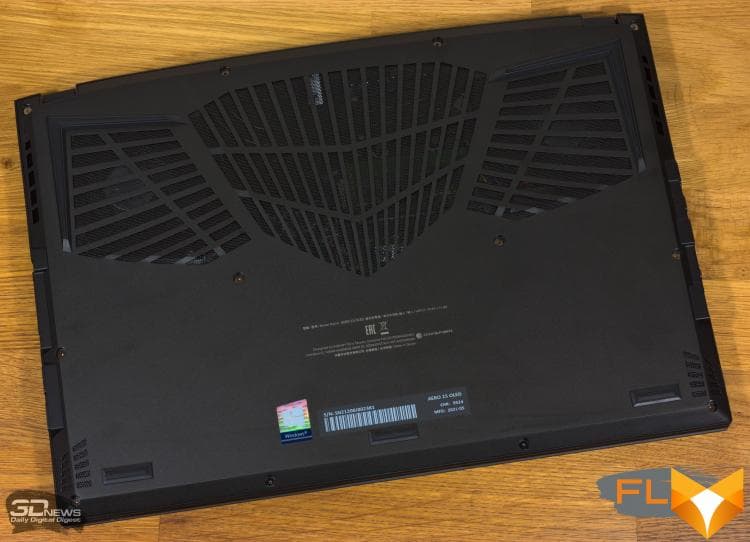
Air enters the case through the mesh, which covers about a third of the entire area of the bottom panel, and exits in three directions: back and sides.
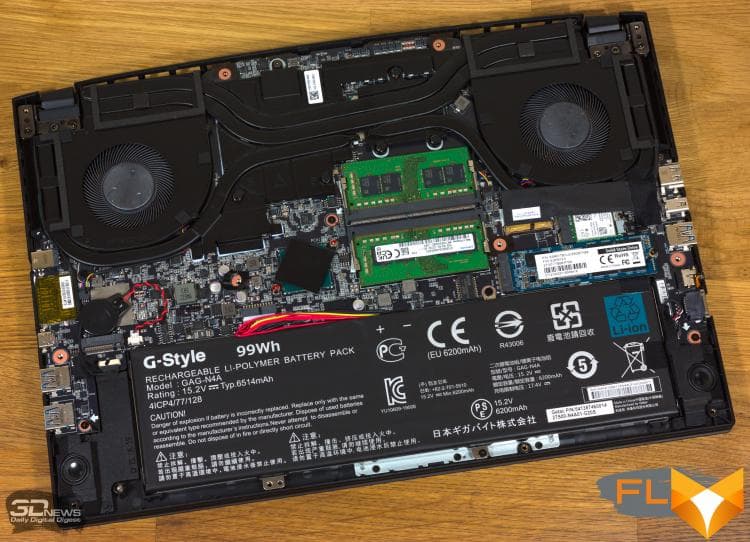
The design of the laptop opens up ample opportunities for upgrading RAM and ROM: RAM is removable here, in the form of SO-DIMM modules, and there is a platform for a second M.2 solid-state drive. span>
⇡#Test Methodology
| Synthetic tests | |
|---|---|
| Application | Settings |
| 3DMark Time Spy | — |
| Geekbench 4 | — |
| CINEBENCH R20 | — |
| GFXBench 5 (Aztec Ruins — Normal Tier, High Tier) | Windows: Vulkan, macOS: Metal |
| fio 3.16 | Sequential read/write, random read/write (unbuffered I/O) |
| Work Applications | |||||
|---|---|---|---|---|---|
| Application | Benchmark | Settings | API | ||
| Intel Graphics | AMD Graphics | NVIDIA Graphics | |||
| Adobe Photoshop CC 2019 | PugetBench for Photoshop CC 0.8 (linked test structure) | Basic Benchmark | OpenGL + OpenCL + Metal (macOS) | OpenGL + OpenCL + Metal (macOS) | OpenGL + OpenCL |
| Adobe Photoshop Lightroom Classic CC 2020 | PugetBench for Lightroom Classic 0.8 (test structure at link) | — | DirectX 12 (Windows) | DirectX 12 (Windows) | DirectX 12 |
| Adobe Premiere Pro CC 2019 | PugetBench for Premiere Pro 0.8 (test structure by reference) | Standard Benchmark | OpenCL (Windows)/Metal (macOS) | OpenCL (Windows)/Metal (macOS) | CUDA |
| Fusion | |||||
| Blender 2.81a | Class Room demo from Blender Foundation | Cycles renderer. Feature Set: Supported. Tile size: 32 × 32 (CPU) or 256 × 256 (GPU) | N/A (CPU rendering) | OpenCL (Windows)/CPU (macOS) | CUDA/OptX |
Display testing is performed using the X-Rite i1Display Pro Plus colorimeter in the DisplayCAL 3 application.
Notebook battery life is measured at a display brightness of 200 cd/m2 in the following usage scenarios:
- web surfing: alternately opening and closing tabs of Computeruniverse.ru and Unsplash.com sites with an interval of 25 seconds in the Google Chrome browser (cache and cookies are disabled);
- Continuous playback of 4K HEVC (H.265) video.
⇡#Test participants
The following devices took part in testing:
| Screen | CPU | RAM | GPU | SSD | HDD | Battery | |||
|---|---|---|---|---|---|---|---|---|---|
| GIGABYTE AERO 15 OLED (XD-73RU644SP) | 15.6”, 3840 × 2160, AMOLED | Intel Core i7-11800H | 8/16 cores/threads, 2.3-4.6GHz | DDR4 SDRAM, 3200 MT/s, 32 GB | NVIDIA GeForce RTX 3070 | 8GB GDDR6 | Phison ESR01TBTLG-E6GBTNB4 (PCIe 4.0 x4) 1024 GB | None | 99 Wh |
| Acer ConceptD 7 Ezel (CC715-71) | 15.6”, 3840 × 2160, IPS | Intel Core i7-10750H | 6/12 cores/threads, 2.6-5.0GHz | DDR4 SDRAM, 2666 MT/s, 16 GB | NVIDIA GeForce RTX 2070 Max-Q | 8 GB GDDR6 | RAID 0: 2 × Samsung PM981a (PCIe 3.0 x4) 512 GB | None | 84 Wh |
| Apple MacBook Pro 13″, Late 2020 (A2338) | 13.3”, 2560 × 1600, IPS | Apple M1 | 4+4 cores/threads, ≤3.2GHz | LPDDR4X SDRAM, 4266 MT/s, 16 GB | 8 iGPU cores | System RAM | Apple AP2048Q (Apple Fabric) 2048 GB | None | 58.2 Wh |
| Apple MacBook Pro 16″, Late 2019 (A2141) | 16”, 3072 × 1920, IPS | Intel Core i9-9980HK | 8/16 cores/threads, 2.4-5.0GHz | DDR4 SDRAM, 2666 MT/s, 16 GB | AMD Radeon Pro 5500M | 4GB GDDR6 | Apple AP1024N (PCIe 3.0 x4) 1024 GB | None | 100 Wh |
| ASUS ROG Flow X13 (GV301QH-K5228T) | 13,4”, 3840 × 2400, IPS | AMD Ryzen 9 5980HS | 8/16 cores/threads, 3.1-4.8 GHz | LPDDR4X SDRAM, 4266 MT/s, 32 GB | NVIDIA GeForce GTX 1650 Max-Q | 4GB GDDR6 | WD PC SN530 (PCIe 3.0 x4) 1024 GB | None | 62 Wh |
| ASUS ROG Flow X13 (GV301QH-K5228T) | 13.4”, 3840 × 2400, IPS | AMD Ryzen 9 5980HS | 8/16 cores/threads, 3.1-4.8GHz | LPDDR4X SDRAM, 4266 MT/s, 32 GB | NVIDIA GeForce RTX 3080 | 16GB GDDR6 | WD PC SN530 (PCIe 3.0 x4) 1024 GB | None | 62 Wh |
| ASUS ROG Mothership (GZ700GX) | 17.3”, 3840 × 2160, IPS | Intel Core i9-9980HK | 8/16 cores/threads, 2.4-5.0GHz | DDR4 SDRAM, 2666 MT/s, 64 GB | NVIDIA GeForce RTX 2080 | 8GB GDDR6 | RAID 0: 2 × Intel SSD 760p (PCIe 3.0 x4) 512GB + Samsung PM981 (PCIe 3.0 x4) 512GB | None | 90 Wh |
| HP ZBook Studio G7 (1J3W1EA) | 15.6”, 1920 × 1080, IPS | Intel Core i7-10850H | 6/12 cores/threads, 2.7-5.1GHz | DDR4 SDRAM, 2933 MT/s, 16 GB | NVIDIA Quadro RTX 3000 Max-Q | 6GB GDDR6 | Samsung PM981a (PCIe 3.0 x4) 512 GB | None | 83 Wh |
| MSI Creator 15 (A10UH-427RU) | 15.6”, 3840 × 2160, IPS | Intel Core i7-10870H | 8/16 cores/threads, 2.2-5.0GHz | DDR4 SDRAM, 3200 MT/s, 32 GB | NVIDIA GeForce RTX 3080 | 16GB GDDR6 | Samsung PM981 (PCIe 3.0 x4) 2048 GB | None | 99 Wh |
| MSI Prestige 14 (A10SC) | 14”, 1920 × 1080, IPS | Intel Core i7-10710U | 6/12 cores/threads, 1.1-4.7GHz | LPDDR3 SDRAM, 2133 MT/s, 16 GB | NVIDIA GeForce GTX 1650 Max-Q | 4GB GDDR6 | Samsung PM981 (PCIe 3.0 x4) 1024 GB | None | 52 Wh |
⇡#Screen Quality
The AERO 15 OLED screen makes a strong impression even with its nameplate specifications. Firstly, it is an AMOLED-matrix with zero luminosity of black pixels and, accordingly, infinite contrast. Secondly, it has a resolution of 4K, that is, 3840 × 2160. But that’s not all. Screen brightness reaches 454 cd/m2, although due to the fact that each OLED pixel is its own light source, and the overall power consumption of the matrix is limited, peak values are achievable only in bright areas of the image against a dark background. The all-white screen glows at a brightness of 373 cd/m2, which is still quite high compared to most screens found in mobile PCs.
The panel’s tint range spans 98% to 99% of Adobe RGB and DCI-P3 spaces. The only pity is that the laptop control software is not able to cut the color coverage, because in the Windows environment only certain applications have their own color management system and, as a result, can correctly display images created in sRGB space on the Wide Gamut screen. All other graphics, including the OS interface, look oversaturated.
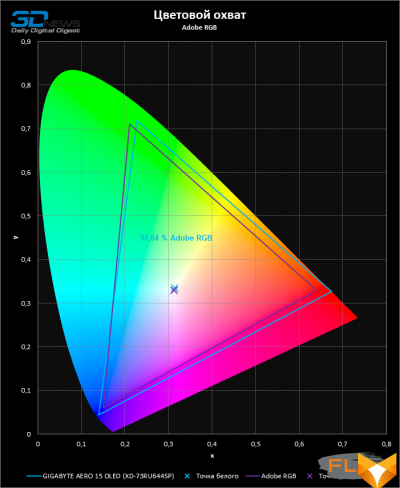 |
 |
However, professionals have been given all the necessary tools to take advantage of the extended color gamut in programs that can work with ICC display profiles. The GIGABYTE Control Center application allows you to set the color temperature of the image in the range from 5800 to 6500 K, and at the same time a profile is attached to the screen that describes its parameters when the color temperature is set accordingly.
It looks like GIGABYTE profiles each AERO 15 OLED individually, or at least the panels are very similar within the same batch, as the color temperature is clearly fixed at 6500 K across the entire gray scale, except for the darkest shades.

The gamma correction curve is not perfect, but in general it follows the 2.2 exponential function quite accurately. But the gray balance, impeccable in light shades, is noticeably disturbed in the dark areas of the image.
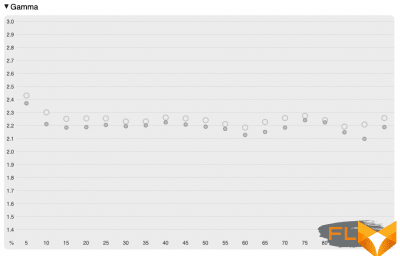 |
 |
Despite that last caveat, the AERO 15 OLED display scored an excellent color accuracy rating with a Delta E 2000 average error of less than one. The thing is that the ICC profile of the device itself does not correct color reproduction defects, but stores all information about them. The results of the last test indicate a high accuracy of profiling, which means that applications with their own CMS will know which screen they are dealing with and will correct the color components of the image in accordance with the parameters of the AMOLED matrix.

⇡#Clock speeds, temperature and noise levels
Formally, of all the chips on the Tiger Lake core, only the older model (Core i9-11980HK) allows you to increase TDP up to 65 W, while the rest of the CPUs marked H operate in the range from 35 to 45 W of power. But the developers of AERO 15 OLED decided otherwise. The Core i7-11800H is overclocked to reach a power consumption of 70W and maintain clock speeds of around 3.6GHz under multi-threaded load, a level that most thin laptops on the Intel platform cannot reach, but is not a problem for the AERO 15 OLED cooling system.
The laptop version of the GeForce RTX 3070 graphics exists in two configurations – with a power reserve of 80 or 125 watts. GIGABYTE chose the first one, but it’s not that simple. The fact is that the AERO 15 OLED, like most high-performance laptops, gives you a choice of several power consumption modes, but the three main presets (the fourth is an economical mode for battery operation) serve not so much to regulate the overall power of the CPU and GPU how much in order to set the priority between these components.
So, the Creator Mode option brings to the fore the speed of the central processor and allows the CPU to develop maximum clock speeds, and the GPU is limited by a power reserve close to the nominal value of 80 W, and keeps an average frequency of 1.17 GHz in work tasks. Gaming Mode, on the contrary, gives preference to the graphics process: its power increases to 90 W, and the frequency – up to 1.35 GHz. The stable power consumption of the CPU, even in the absence of an intensive graphics load in the “game” mode, does not exceed 45 W, and the clock frequency of the x86 cores fluctuates around 3 GHz. If both chips are fully loaded at the same time, the difference between the two modes is all the more noticeable.
Finally, there is the Turbo Mode option, when the cooling fans always rotate at maximum speed. From the point of view of power distribution during an isolated load on the central or graphics processor, this mode is similar to Creator Mode, only the average CPU frequency is slightly reduced, and the GPU, on the contrary, is increased, albeit not to such values as in the “game” mode. But with a combined load under Turbo Mode, the power consumption of both chips is almost the same and amounts to 66-67 W, which, in terms of clock frequencies, shifts the balance in favor of the central processor. Therefore, Turbo, and not Creator Mode at all, is the best mode for this kind of task, when high performance is still required from the GPU, but CPU speed is most important.
| Load Clock | ||||||||
|---|---|---|---|---|---|---|---|---|
| Cinebench R20 (Max Thread #) | LuxMark 3.1 | Cinebench R20 (Max Thread #) + LuxMark 3.1 | ||||||
| CPU clock speed, MHz | GPU clock speed, MHz | CPU clock speed, MHz | GPU clock speed, MHz | |||||
| Average | Max | Medium | Max | Medium | Max | Medium | Max | |
| GIGABYTE AERO 15 OLED (XD-73RU644SP) – Intel Core i7-11800H / NVIDIA GeForce RTX 3070 – Turbo Mode td> | 3596 | 3791 | 1208 | 1245 | 3251 | 3392 | 951 | 1020 |
| GIGABYTE AERO 15 OLED (XD-73RU644SP) – Intel Core i7-11800H / NVIDIA GeForce RTX 3070 – Creator Mode td> | 3633 | 3691 | 1169 | 1245 | 2718 | 3990 | 1144 | 1260 |
| GIGABYTE AERO 15 OLED (XD-73RU644SP) – Intel Core i7-11800H / NVIDIA GeForce RTX 3070 – Gaming Mode td> | 3001 | 3275 | 1301 | 1320 | 2498 | 2594 | 1286 | 1305 |
| CPU and GPU power | ||||||||
|---|---|---|---|---|---|---|---|---|
| Cinebench R20 (Max Thread #) | LuxMark 3.1 | Cinebench R20 (Max Thread #) + LuxMark 3.1 | ||||||
| CPU power consumption, W | GPU power consumption (SoC as a whole, if integrated), W | CPU power consumption, W | GPU power consumption (if discrete), W | |||||
| Medium | Max | Medium | Max | Medium | Max | Medium | Max | |
| GIGABYTE AERO 15 OLED (XD-73RU644SP) – Intel Core i7-11800H / NVIDIA GeForce RTX 3070 – Turbo Mode td> | 70 | 78 | 83 | 83 | 67 | 68 | 66 | 66 |
| GIGABYTE AERO 15 OLED (XD-73RU644SP) – Intel Core i7-11800H / NVIDIA GeForce RTX 3070 – Creator Mode td> | 70 | 71 | 82 | 82 | 50 | 54 | 83 | 83 |
| GIGABYTE AERO 15 OLED (XD-73RU644SP) – Intel Core i7-11800H / NVIDIA GeForce RTX 3070 – Gaming Mode td> | 45 | 46 | 92 | 92 | 45 | 45 | 91 | 91 |
Note The measurement is performed after the device has warmed up and all parameters have stabilized.
Overheating does not threaten the AERO 15 OLED components. The GPU temperature is in the range of 83 °C, and the CPU temperature is 93 °C.
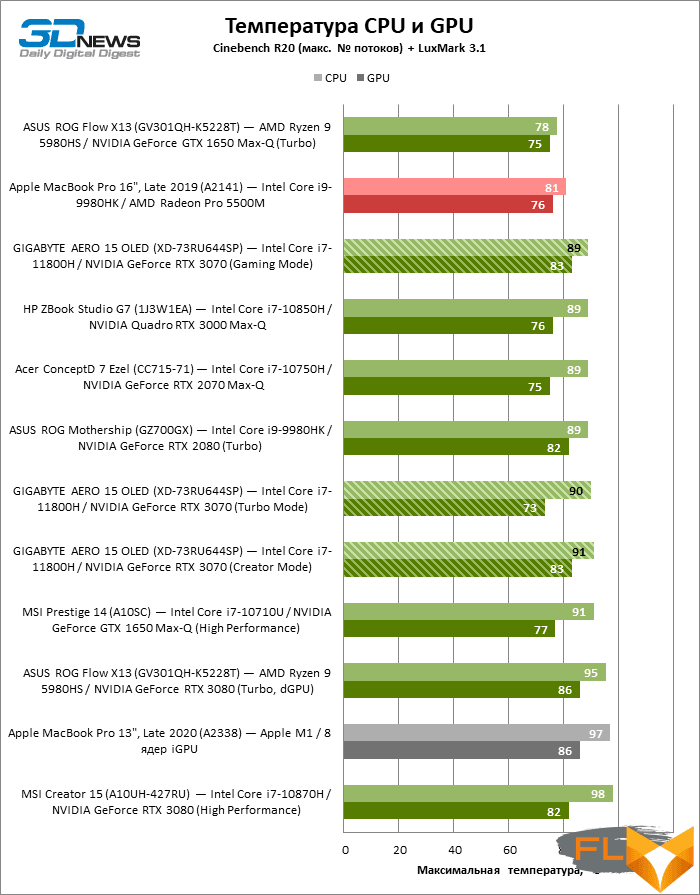
Alas, a predictable side effect of such a high power of the main components, combined with enhanced cooling, is a high level of noise. In Creator or Gaming Mode, the laptop is about as loud as most of the other mobile workstations that we took for comparison, but if you turn on Turbo Mode, using the computer is already completely uncomfortable – except perhaps in order to start rendering some project and go for a smoke break.

⇡#Synthetic benchmarks
The results of AERO 15 OLED processor benchmarks in comparison with the results of other mobile workstations are very categorical: among all the laptops we have ever tested, the GIGABYTE product has the highest performance in both single-threaded and multi-threaded workloads. Thanks to 11th generation Intel silicon. Although it must be admitted that the Core i7-11800H achieves such results only at the cost of significantly higher power consumption at almost the same frequencies as the Ryzen 9 5980HS, so it’s better to wait a bit with the coronation of the new leader in mobile CPUs.
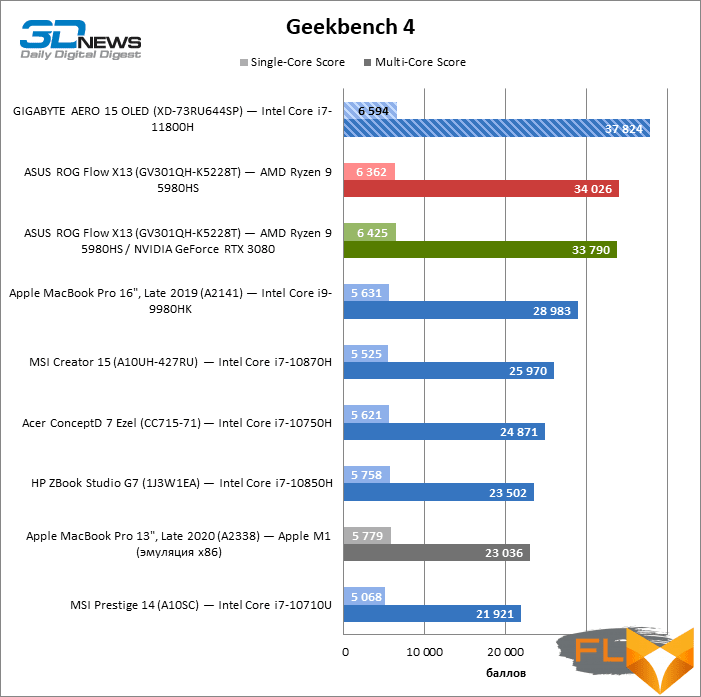
The discrete graphics GeForce RTX 3070, of course, is inferior in performance to the best mobile solution to date – the RTX 3080, but according to synthetic tests, the difference between them is not so great.
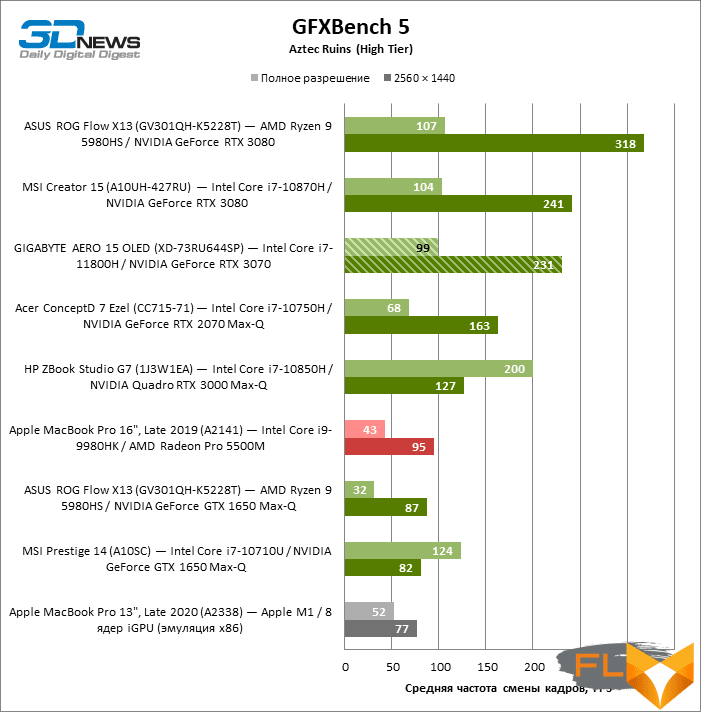
⇡#Performance in production applications
The CPU rendering test in Blender confirmed the preliminary performance score of the Core i7-11800H. It’s been a while since we’ve seen an Intel mobile CPU compete in rendering speed with AMD’s best offerings! But then the turning point came: the Tiger Lake chip, and not the oldest in the series, was ahead of the pre-top model of the Ryzen 5000 series. Yes, only thanks to overclocking, which is accompanied by a sharp increase in power consumption, but if performance is at the forefront, it is quite possible to ignore the relatively low energy efficiency.
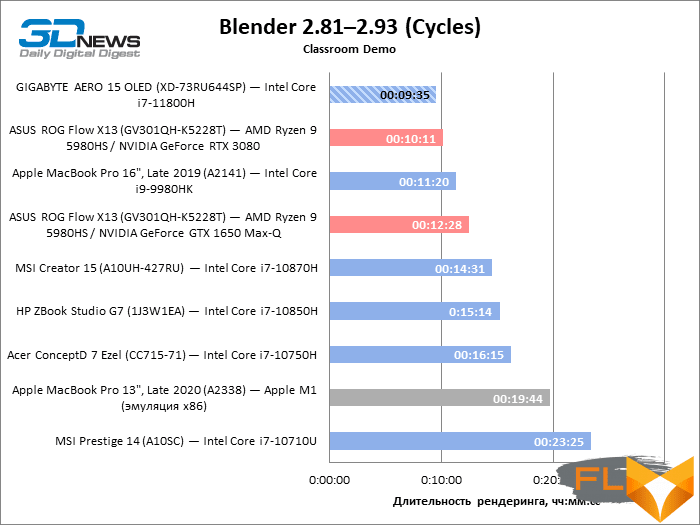
The results of the same benchmark, but already using a discrete GPU, once again show that if the cooling of the laptop allows the GeForce RTX 3070 to allocate a solid power reserve, this accelerator is only slightly inferior to the older model of the series and at the same time the most high-performance of modern laptop video adapters – RTX 3080 While the key difference between the two NVIDIA products is the amount of VRAM (8GB or 16GB), the RTX 3070 doesn’t run out of local memory for relatively light 3D modeling tasks.

Adobe’s photo-editing applications fit well with the Tiger Lake processor architecture. As a result, it’s no surprise that the GIGABYTE AERO 15 OLED took the lead in the Lightroom benchmark. The advantage of a workstation on a modern Intel platform is especially great in passive tasks, that is, when using filters, stitching panoramas, etc.

Note Scores are calculated as a percentage of Intel Reference Workstation performance Core i9-9900K, NVIDIA GeForce RTX 2080, 64GB RAM.
The Photoshop benchmark GIGABYTE AERO 15 OLED allows us to draw the same conclusions, and here it is the undisputed leader.
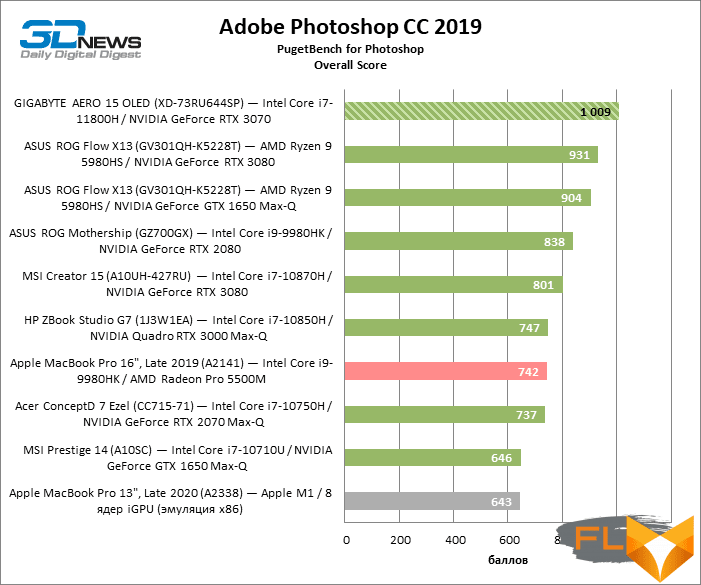
Note Scores are calculated as a percentage of Intel Reference Workstation performance Core i9-9900K, NVIDIA GeForce RTX 2080 and 64GB RAM x 10.
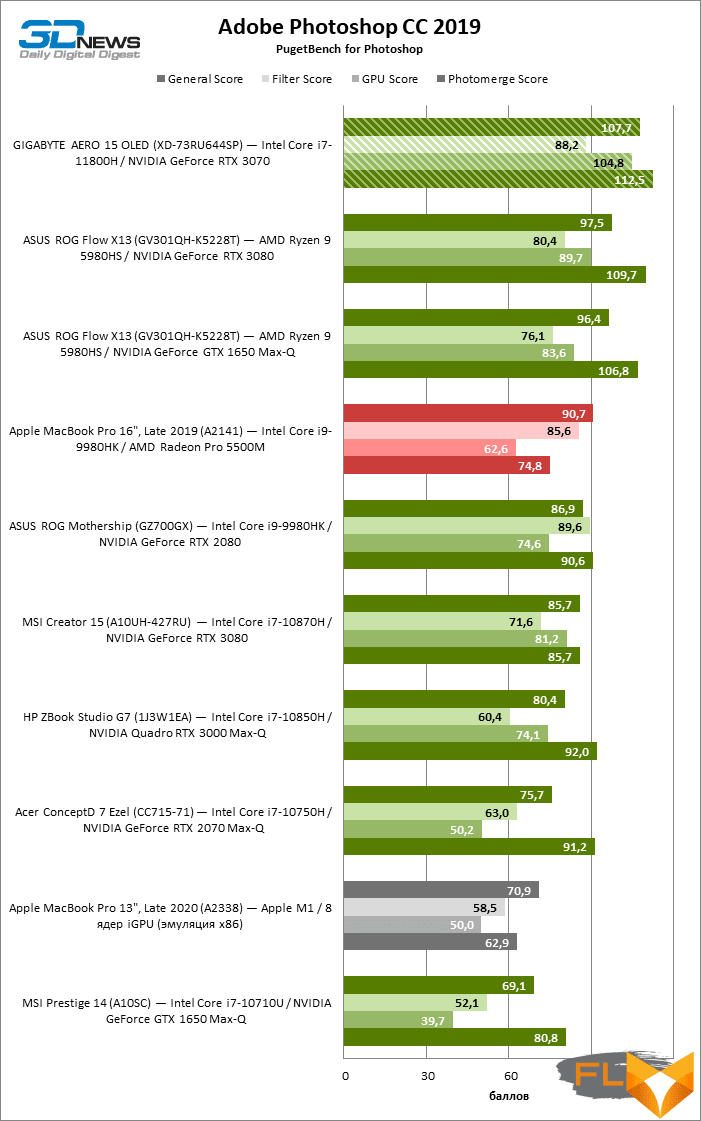
Note Scores are calculated as a percentage of Intel Reference Workstation performance Core i9-9900K, NVIDIA GeForce RTX 2080, 64GB RAM.
In Premiere Pro, you guessed it, the GIGABYTE AERO 15 OLED took first place in both frame rate during project playback and render time.
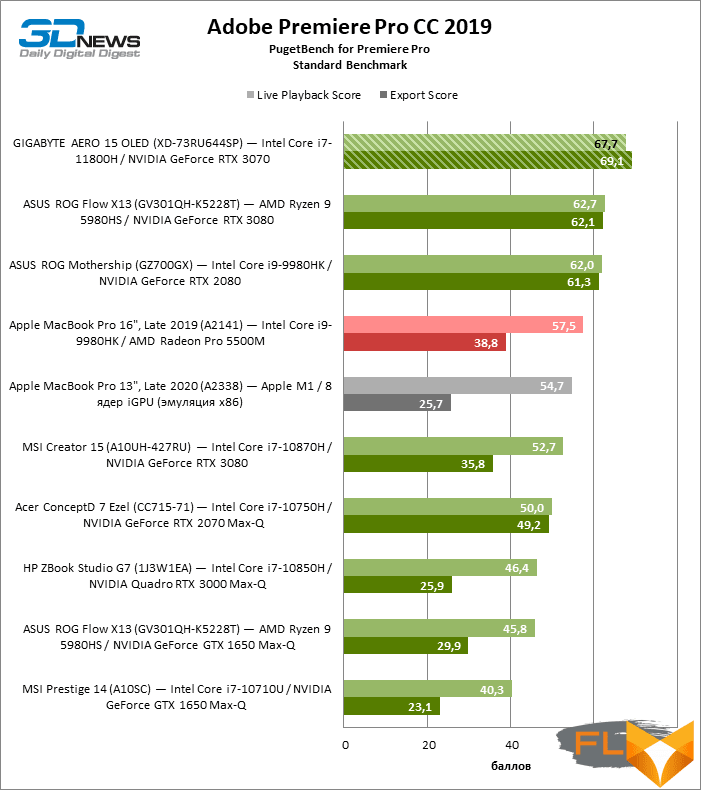
Note Scores are calculated as a percentage of the frame rate of the source or target format (for example, playing a video at full frame rate is worth 100 points). Unlike playback, when rendering video, the frame rate can exceed the target, which means that the score will be higher than 100.
In absolute terms, the laptop provides a frame rate of about 60 FPS when playing 4K video with complex effects based on either the central processor or the graphics processor (albeit using a proxy that reduces the resolution by half). Again, the mobile versions of the GeForce RTX 3080 are capable of delivering higher frame rates, but in this case the difference does not exceed a couple of FPS. At the same time, the advantage of a modern Intel CPU compared to the top Ryzen 5000 models is very noticeable here.
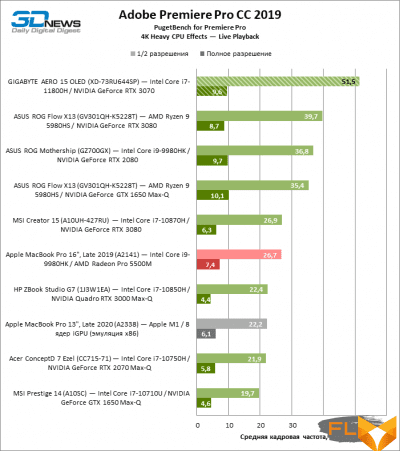 |
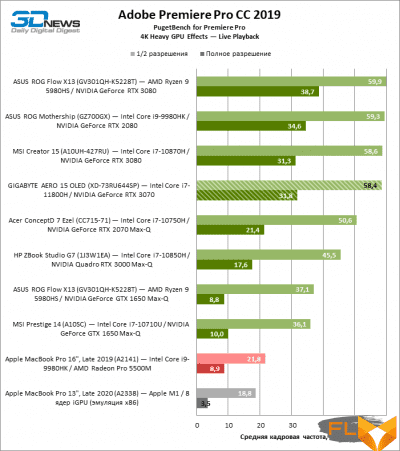 |
The Core i7-11800H chip also made GIGABYTE the leader in project export speed. But when it comes to encoding video loaded with GPU effects, a more powerful video adapter than the GeForce RTX 3070 clearly does not hurt. Finally, working with video in 8K resolution is significantly limited or simply impossible when the GPU has only 8 GB of local memory.
 |
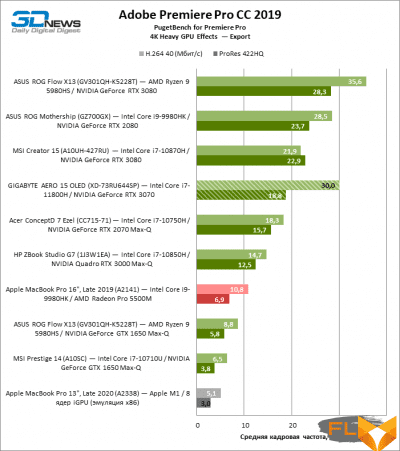 |
The GIGABYTE AERO 15 OLED outperformed all rivals in the DaVinci Resolve video editor tests as well, with a particular advantage in the speed of Fusion effects, which rests on the performance of the CPU. The only pity is that here we can’t push the GIGABYTE computer with devices on the older CPUs of the Ryzen 5000 family: for some reason, the DaVinci Resolve benchmark did not start on the ROG Flow X13 laptop, one of the most high-performance “red” machines.
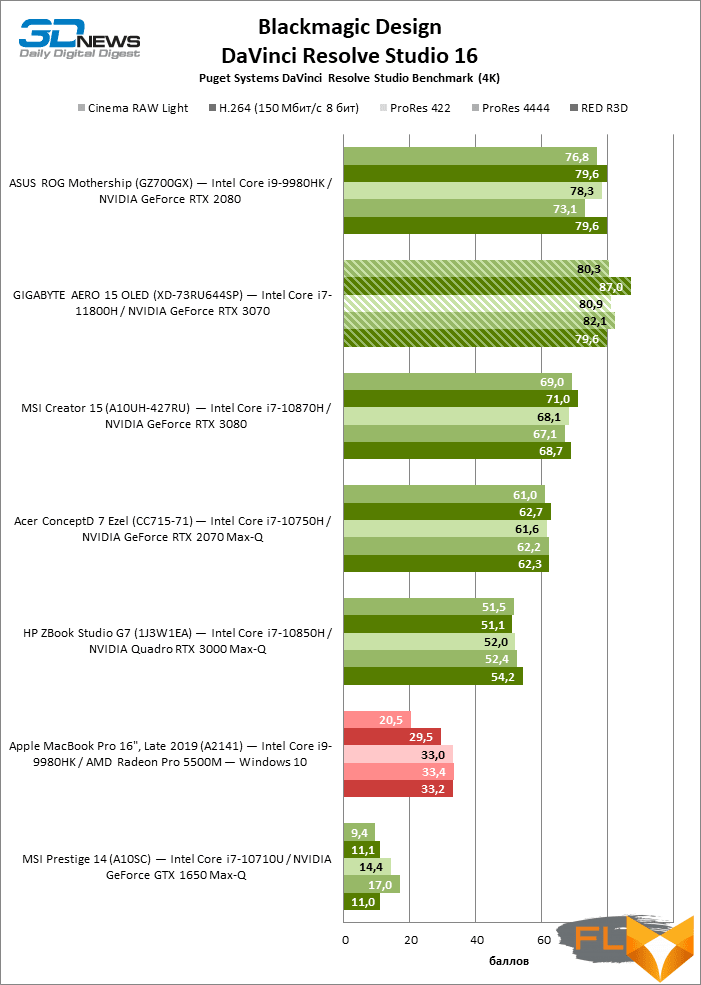
Note Scores are calculated as a percentage of Intel Reference Workstation performance Core i9-9900K and NVIDIA TITAN RTX.
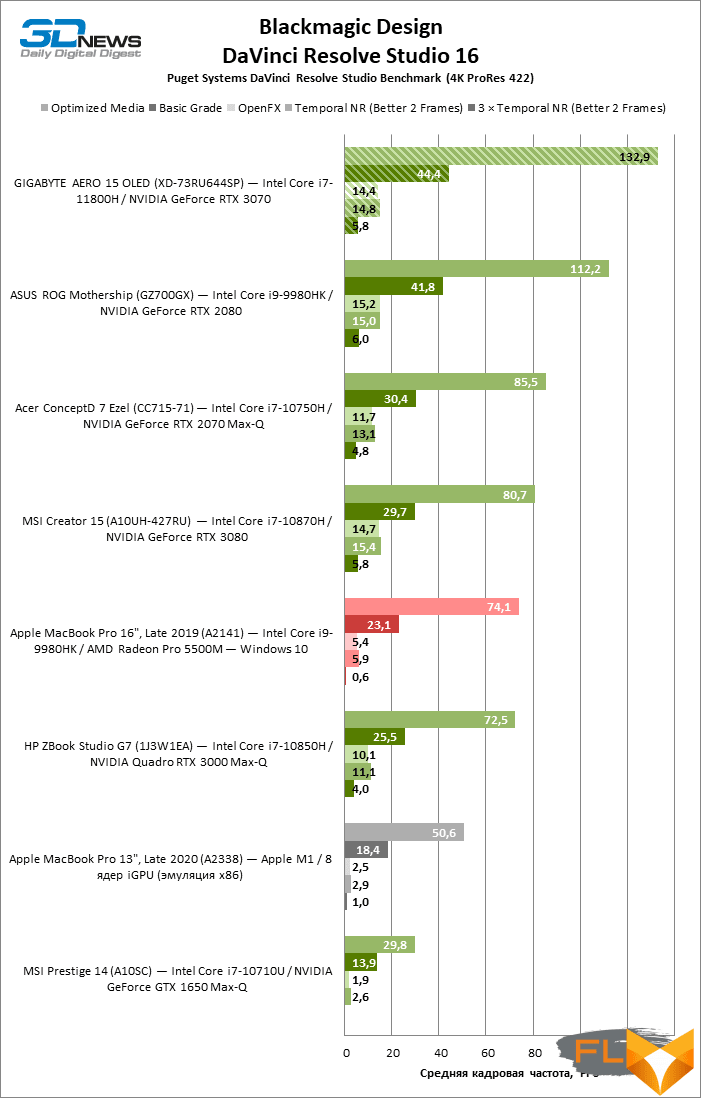
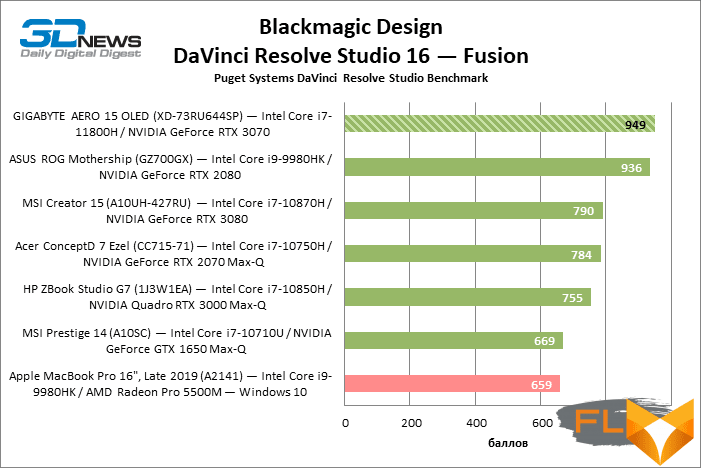
Note Scores are calculated as a percentage of the performance of a reference workstation based on Intel Core i9-9900K and NVIDIA TITAN RTX multiplied by 10.
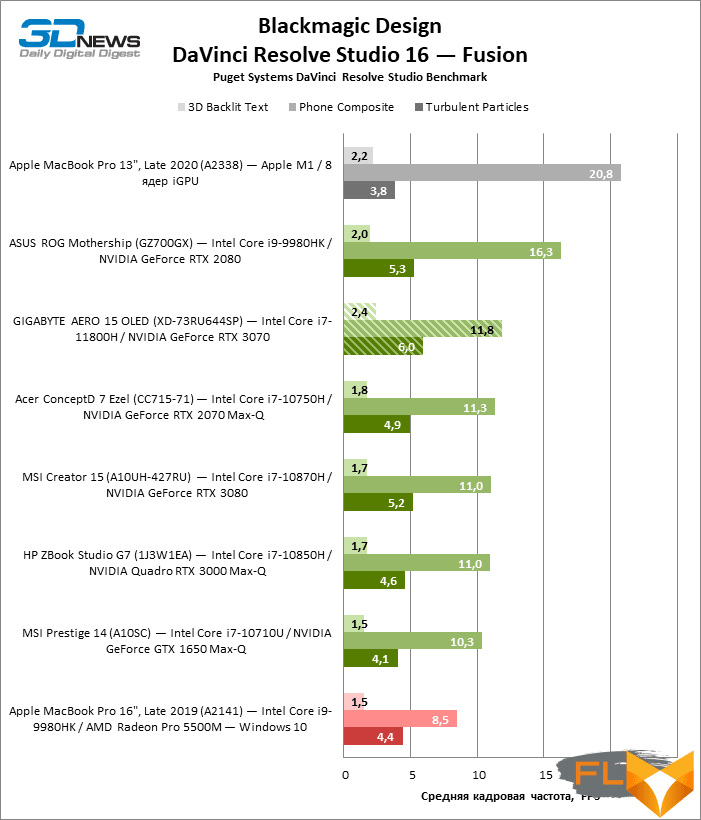
SSD performance
One of the key innovations of Intel’s Tiger Lake platform is support for the fourth generation PCI Express bus, which is needed not only and not so much for modern GPUs, but in order to double the potential throughput of solid state drives. Of course, in practice, such results are unattainable, and yet the SSD on the Phison controller installed inside the GIGABYTE AERO 15 OLED significantly outperforms the best solutions with the PCI Express 3.0 interface, which are most often used in laptops, in sequential block read speed. Moreover, this SSD is the leader in the tasks of reading and writing to random addresses, but its linear write speed, as it turned out, is rather mediocre.
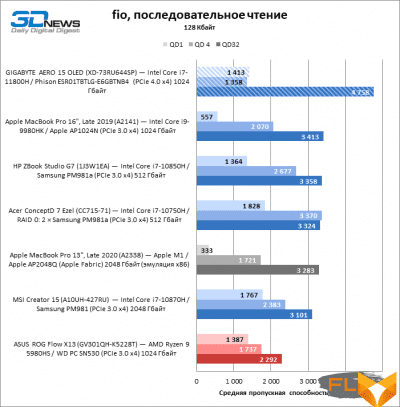 |
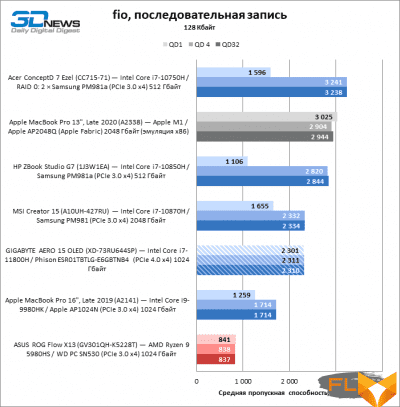 |
 |
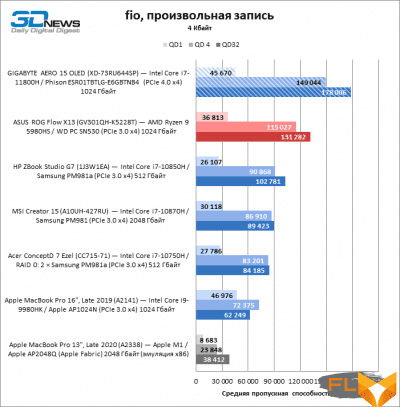 |
⇡# Battery Life
Despite the fact that the GIGABYTE AERO 15 OLED has the most capacious battery that can only be installed in a laptop (99 Wh), and there is an energy-saving mode, its owner should not count on long-term work away from the mains. Even with the screen brightness reduced, the computer managed only 5 hours and 37 minutes of video playback, which can be considered an acceptable, although far from outstanding result. But the duration of web surfing is a little less than three hours – this is clearly not what buyers of modern laptops are used to.
⇡#Conclusions
The upgraded version of the GIGABYTE AERO 15 OLED has become, in several ways, the best laptop among all mobile workstations that have passed through us. In most tasks, it demonstrated unsurpassed performance, sometimes outperforming machines that are equipped with formally more powerful hardware, and in fact, we also got not the oldest modification of the AERO 15 OLED for review. It’s all about sanctioned CPU overclocking and a proper cooling system that allowed Intel’s 11th generation silicon to beat AMD’s best mobile chips. Although, to be honest, these achievements can be presented in a different perspective: the complete defeat of the “red” eight-core did not take place, and the Intel processor already has to work far beyond the standard TDP.
Be that as it may, in terms of absolute performance in work tasks, it is difficult to find equal rivals for AERO 15 OLED. In addition, the GIGABYTE laptop got a stunning 4K screen with all the advantages of AMOLED technology, and carefully calibrated. Add to this a full-sized keyboard with a numeric keypad and a wide range of external interfaces, including cable network.
Of course, the novelty is not without flaws, quite typical for this category of laptops. The performance records were broken by the AERO 15 OLED at the price of a high noise level, and the battery life leaves much to be desired. However, the buyer of a powerful workstation certainly knows what he is getting into, and should be prepared for such compromises.

